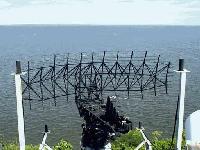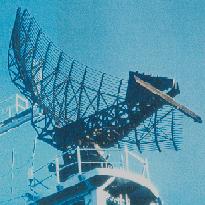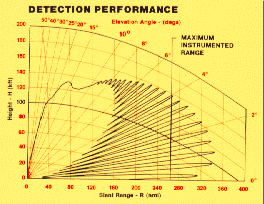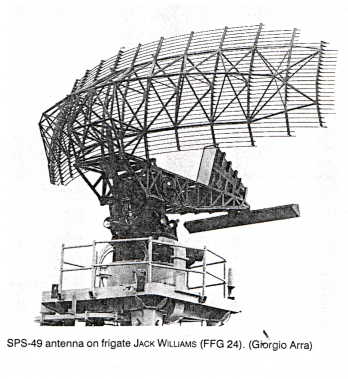






The AN/SPS-49 long range 2-dimensional air surveillance radar used for early target detection. The long-range AN/SPS-49 radar operates in the presence of clutter, chaff, and electronic counter-measures to detect, identify, and control low-radar-cross-section threats traveling at supersonic speeds. AN/SPS-49 provides the front-end element for successful target identification, designation, and engagement with either long range (SM-1 or SM-2) missiles and/or short range local defense missiles. A key feature of the most recent version of the radar, the SPS-49A(V)1 is single-scan radial velocity estimation of all targets allowing faster promotion to firm track and improved maneuver detection. This is done using unique signal processing techniques originated and tested by the Radar Division of NRL using 6.1 and 6.2 Office of Naval Research (ONR) funds.
The AN/SPS-49(V) radar is a narrow beam, very long range, 2D air search radar that primarily supports the AAW mission in surface ships. The radar is used to provide long range air surveillance regardless of severe clutter and jamming environments. Collateral functions include air traffic control, air intercept control, and antisubmarine aircraft control. It also provides a reliable backup to the three-dimensional (3D) weapon system designation radar.
Band L
Frequency Band: 850 to 942 MHz
three selectable 30MHz bands
48 discrete frequencies
Transmitting Power: 360 kW peak
280 kW specified peak power
12-13 kW average power
Antenna Parameters:
Parabolic Reflector stabilized for roll and pitch
7.3m/24 ft wide, 4.3m/14.2 ft high
Rotating Clearance 8.7m/28.4 ft diameter
Beamwidths: 3.3°-3.3° azimuth
11° elevation
Cosec2 to 30°, csc2 to 20° elev
Gain 28.5 dB
Scan rate 6 or 12 rpm
Line-of-sight mechanical stabilization to ± 25 deg roll
IFF antenna (AS-2188) mounted on boom
Range 250 nm
Minimum Range : 0.5 nmi
Frequency Selection: Fixed or frequency agile
Range Accuracy: 0.03 nmi
Azimuth Accuracy: 0.5 deg
PRF 280, 800, 1000 pps
Pulse width 125 microsecond
The AN/SPS-49(V) radar operates in the
frequency range of 850 - 942 MHZ. In the long range mode, the AN/SPS-49
can detect small fighter aircraft at ranges in excess of 225 nautical miles. Its
narrow beamwidth substantially improves resistance to jamming. The addition
of coherent side lobe canceller (CSLC) capability in some AN/SPS-49(V)
radars also provides additional resistance to jamming/interference by
cancelling the jamming/interference signals. The moving target indicator (MTI)
capability incorporated in the AN/SPS-49(V) radar enhances target detection
of low-flying high speed targets through the cancellation of ground/sea return
(clutter), weather and similar stationary targets. In 12 RPM mode operation,
this radar is effective for the detection of hostile low flying and "pop-up"
targets. Features of this set include:
There are currently nine configurations of the AN/SPS-49(V).
|
Variant |
Description |
Ship Class |
|
AN/SPS-49(V)1 |
Developed in the early 1970s. Included sidelobe cancellation and digital MTI, with Coherent Sidelobe Canceller (CSLC) that electronically cancels jamming. Video outputs provided to PPI displays. |
CV, CVN, CG, DDG 993, LHD1, DD997, LSD41 |
|
AN/SPS-49(V)2 |
Without CSLC |
FFG 7 |
|
AN/SPS-49(V)3 |
(V)1 system modified to interface with a Radar Video Processor (RVP) |
CGN 9 |
|
AN-SPS-49(V)4 |
(V)2 system modified to interface with RVP |
FFG 7 |
|
AN/SPS-49(V)5 |
(V)1 system modified to provide an automatic target detection (ATD) capability and improved ECCM features. Developed in the early 1980s. Added automatic detection and Doppler processing. Digital outputs provided to an associated tracker. |
New Threat Upgrade (NTU) |
|
AN/SPS-49(V)6 |
(V)3 system with double shielded cables and a modified cooling system |
CG 47 |
|
AN/SPS-49(V)7 |
(V)5 system with a (V)6 cooling system |
AEGIS Platforms |
|
AN/SPS-49(V)8 |
(V)5 system enhanced to include the AEGIS Tracker modification kit |
AEGIS Platforms |
|
AN/SPS-49A(V)1 |
Developed in the mid 1990s. Added radial speed determination on each target, each scan. Improved clutter rejection |



